Kayaking is a fun, exciting, and unique activity that adrenaline seekers will love. As for any other sport, there are risks involved. But it’s not everyone that has to kayak in huge waterfalls or dangerous rapids.
You can also paddle in a calm and safe environment if you just want to relax on the water. Thus, the level of danger you face when kayaking might change from one case to another. However, it’s always better to know how risky an activity is before getting started.
Is Kayaking Dangerous?
Kayaking can be dangerous, but it doesn’t have to be. With proper equipment and preparation, you can safely practice this water sport. Most dangers involved when paddling in a kayak are easy to avoid. However, kayaking still exposes you to risks of capsizing, sunburns, dehydration, wild animal attacks, and injuries.
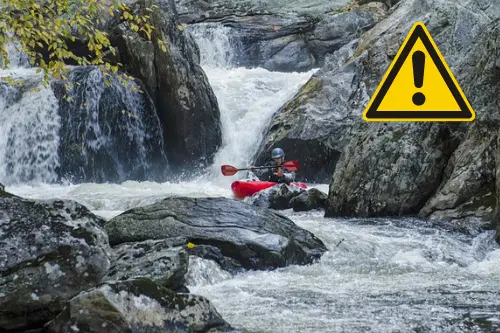
On the other hand, you shouldn’t forget how fun and beneficial kayaking can be. Most of the time, you will be more scared than hurt while paddling on the water.
I’ve done it for pretty much all my life, and I’m alright. The worst thing that happened to me was probably swallowing some water and injuring my feet while walking barefoot on sharp rocks. So kayaking isn’t as dangerous as most people think.
What Are The Risks Of Kayaking?
The term “dangerous” can leave room for interpretation. Your perception of what’s risky and what’s not is probably different than mine.
For example, my dad thinks kayaking is relatively safe because he’s good at it and knows how to avoid most dangers. On the other hand, my mom would not agree with him at all.
That’s why I want to share with you the actual risks involved in paddling sports. With that information, it will be easier to draw your own conclusion about how dangerous kayaking is according to your situation.
Where you plan to paddle can influence a lot of what the potential risks are. So it’s essential to consider the environment in which you will kayak to understand whether it’s safe or not. Otherwise, you might perceive dangers that don’t even apply in your case.
Risks To Kayak In Lakes, Slow Rivers, Etc.
In flat and calm water, there are much fewer potential dangers. Fortunately, it’s where most people get started with kayaking. But you should still be aware of a few things to stay safe while paddling in a lake, slow river, bay, etc.
Capsize.
The principal risk of kayaking is generally to capsize. It’s less likely to happen in flat water, but it will if you make a mistake. You should know that some models can flip over more easily than others. (Here’s why!)
The kayak cockpit design will also influence how dangerous a capsize can be. With a sit-on-top, you should fall out of the boat in the water as it flips over. On the other hand, you might get stuck upside down in a capsized sit-inside kayak.
In this case, you have to perform a wet exit. First of all, it’s essential to stay calm. Otherwise, you won’t be able to think clearly and react correctly.
How To Do A Wet Exit From A Kayak?
Getting out of an overturned kayak isn’t too complicated. Here’s a simple technique to perform a wet exit. If you don’t wear a spray skirt, you can skip the first 3 steps.
- Lean Forward
- Slide Your Hands On The Spray Skirt.
- Find The Grab Loop & Pull It.
- Put Your Hands On The Kayak.
- Bend Your Knees Together.
- Push Yourself Out Of The Kayak.
- Your PDF Will Bring You Back Up To The Surface.
Therefore, flipping over in calm water isn’t a big concern. As long as you practice the wet exit technique a few times and wear a life jacket, you shouldn’t worry too much about capsizing.
Weather.
Extreme temperatures can be an issue when kayaking. If you don’t have the right outfit for the meteorological conditions, you’re at risk. Whether it’s too cold or too warm, you can get into trouble.
During the summer, it’s fun to kayak in a bathing suit. But you might get exposed to the sun for an extended period, which can be dangerous. Without any precaution, you can be vulnerable to sunburn, heat exhaustion, heatstroke, dehydration, etc.
The weather can also increase the risk of kayaking. Heading out in the water during a storm or strong winds isn’t safe nor fun. As soon as you hear thunder or see lightning, it’s time to call it a day.
It doesn’t have to be sunny all the time, but you need to be well-dressed according to the climate. Capsizing in cold water isn’t agreeable. (I’m talking by experience, believe me!) Hypothermia and cold shock are real dangers when the air or/and the water temperature are freezing.
Wildlife.
Calm water environments are often full of wild animals, which can be potentially dangerous for paddlers. In certain places, you might encounter alligators, snapping turtles, or venomous snakes.
They will generally not attack humans as long as they don’t feel threatened. So you should always be alert and try to keep your distance as much as possible. It’s a risk, but animal attacks on kayakers rarely happen.
So, Is Kayaking In Calm Water Safe?
You tell me. In my opinion, there aren’t a lot of risks to flatwater kayaking, and they are easy to avoid. That’s why lakes, slow rivers, and bays are generally not dangerous places to kayak.
Dangers Involved While Kayaking In Whitewater & Rapids.
Some rivers have stronger currents than others, which can form waves and downstream. As fun as rapids can be, kayaking in whitewater also comes with more risks. Let’s take a closer look at them.
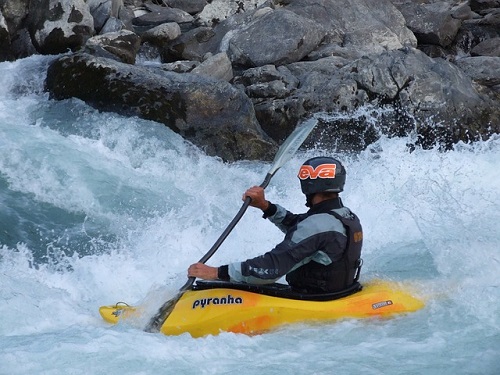
Capsize.
In moving and unpredictable water, your kayak is more likely to flip over. Even if you don’t make an error, the currents and waves make it hard to keep your balance. Thus, the risk of capsizing is significantly higher in whitewater.
What should you do if you flip over while kayaking in a rapid? First, you have to lean forward and keep your upper body close to the boat. It will prevent you from knocking your head on a rock. Once the water is calm or deep enough, you can recover with your favorite method. (Roll or Wet Exit)
If you get out of your kayak in whitewater, lay flat on your back with your feet in front. When it’s safe, you can swim on the side of the river and get ready for a relaunch.
As you can see, capsizing in rapids is more dangerous than in flat water. However, it’s not as risky as most people think when you know what to do and wear the right equipment.
I’ve flipped over many times while kayaking in whitewater, and there’s often more fear than hurt. But the risks are there, so it could end badly if you do something wrong or the river isn’t safe to paddle in.
Waves & Currents.
Kayaking in a river is not as easy as in calm water because you can’t always go where you want. The current might push you or make you capsize in dangerous sections of a rapid.
Whitewater can also form upstream waves, so the water circulates on top of itself. Sometimes, they are powerful enough to keep you stuck. Kayakers can use different terms to define them, such as sticky holes, stoppers, hydraulics, etc.
To get out of a small one, you can intentionally capsize. Your body in the water should be pushed by the bottom current and exit the sticky hole. Then, you can roll or use another recovery technique to continue.
So the waves and currents found in rapids can increase the risks related to whitewater kayaking. But everything should be alright if you know how to read a river and avoid dangerous sections.
Obstacles. (Rocks, Sweepers, Strainers, etc.)
Another thing you will have to deal with in rapids is the rocks, trees, or anything that might be on your way down the river. They can not only increase your chances of capsizing but also make dangerous obstacles.
Rocks are all over the place in a river. There are some on the sides, at the bottom, and in the middle of the rapids. Consequently, rocks represent a risk for you because they can be slippery, on your way, and potentially harmful.
There are often solid obstacles in whitewater, so you should always wear a helmet to protect your head. Otherwise, getting knocked down by a rock without protective gear can put you in a dangerous or even fatal position.
There are some rocks kayakers should stay away from, such as undercuts. It’s a rock that forms a cave because of water erosion. You might get stuck under one if you’re not careful enough, which can be deadly in the worst-case scenario.
Besides rocks, you will encounter other debris while paddling in the river. Logs and branches can also be dangerous obstacles. They are the principal cause of strainers and sweepers.
A strainer is an object that allows water to flow through, but not your kayak. With the downstream current and this obstacle, you can get trapped underwater. So it’s essential to stay away from a section like this while paddling in whitewater.
A sweeper is a tree that either bends low over the river or has fallen across it partially submerged. Thus, it can obstruct you from passing through safely. If you see one, you should probably perform a portage to avoid this risky section.
With all the obstacles there are in rivers, you must be careful. Otherwise, you’re likely to hurt or injure yourself. As long as you understand the potential dangers, you shouldn’t have any problem avoiding them.
Other Risks Of Paddling In Rapids.
The hazards related to weather and improper equipment also apply here. For wild animals, an encounter is more likely to happen in calm or flat water. But most rivers aren’t only composed of whitewater sections.
Inexperience can also be problematic in technical or dangerous rapids. Without the proper knowledge and skills, the chances of getting in a risky position will drastically increase.
So, Is Whitewater River Kayaking Safe?
Paddling in rapids is generally the most dangerous type of kayaking. The list of risks involved is relatively long, and whitewater rivers are unpredictable. With the waves, currents, and obstacles, it’s not the safest environment to kayak in. Although it can be fun and exciting, it’s also dangerous.
Learn more about how dangerous whitewater kayaking is!
Hazards To Kayak In The Ocean.
Paddling in the sea can be fun, but it also has its own risks. This large and deep body of water offers a unique experience. Although the ocean is less unpredictable than a river, kayaking in this environment requires more knowledge and preparation than in a lake.
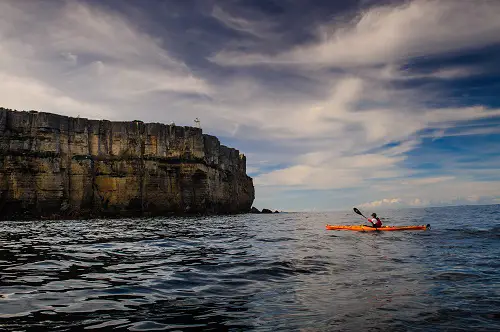
Capsize.
Once again, you can flip over if you lose your balance while paddling. Sea kayaks are generally less stable, but they won’t fill up and sink when upside down. Thus, you can either roll or try to self-rescue yourself in case of capsizing.
But if you can’t get back in your kayak and you’re away from the shore, you have a problem. That’s why you need to master a recovery technique for kayaking in the ocean safely. The risk of tipping over is also relatively higher because the water isn’t always flat and calm.
Tides & Currents.
Depending on where and when you head out in the sea, you might have to deal with water level changes. At certain places, rip and tidal currents can be dangerous for kayakers. If you’re stuck in one, the solution is to stay calm and paddle on the sides.
Waves.
They can be fun to surf on as well as challenging to go through. Either way, the waves are often inevitable in the ocean. Whether you like them or not, they are part of the sport.
Large and breaking waves can make your paddling adventures more dangerous. They will increase the risk of capsizing and the difficulty of recovering from one. So it’s essential to ensure the waves are safe for kayaking before heading out in the sea.
Sharks.
Even though attacks on paddlers rarely occur, you shouldn’t take any chances. Ocean predators are still a potential danger to us. Therefore, try to avoid kayaking in places where there are sharks as much as possible.
Other Boats.
Another risk is getting hit by a big ship. They might not even see you, and they go faster than we think. So it’s always better to stay away from other boats and make yourself as visible as possible.
Getting Lost.
From the sea, locating where you have launched on the coast can be a real challenge. Every beach, rock, and landscape can seem familiar without a closer look. Thus, it’s easy to get lost if you don’t know the area well.
Not knowing where you need to paddle isn’t a fun experience, so you should take precautions to avoid it. The easy solution would be to join someone that often kayak where you plan to go. You can also carry a compass, GPS, or map to find the right way by yourself.
Weather.
The meteorological conditions should also be appropriate for you to head out into the ocean safely. Bad weather can have a significant impact on the waves and increase the potential risks involved. So it’s essential to look at the forecast before every paddling adventure.
On the sea, the temperature can drop, and the wind can pick up quickly. That’s why you should always be aware and ready for any weather change. Bringing as many outfits as possible will ensure you to be comfortable regardless of what happens while kayaking.
For example, you should have extra dry clothing in case you fall in the water. Otherwise, a sudden temperature decrease and the wind can lead to hypothermia.
It’s also never safe to kayak in open water during a thunderstorm. Lightning will hit the highest thing it can, which might be you. Therefore, you should stay at home when the weather is not appropriate.
So, Is Kayaking In The Ocean Safe?
The sea involves different risks than a river and a lake, but it doesn’t mean it’s safe. With the waves, tides, currents, and sharks, paddling in the ocean is relatively dangerous. But with the right kayak, gear, preparation, and skills, you can avoid most potential hazards.
Here’s more information about kayaking in the ocean!
Dangerousness Of Lake VS Whitewater VS Sea Kayaking
Flatwater is the safest environment for kayaking. That’s why it’s the best place to start for beginners. On the other hand, a river with rapids and the ocean are dangerous places to paddle in at a similar level.
It’s hard to rank them in order because the risks are different, and it’s specific to each spot. However, I think kayaking in the sea is generally less dangerous than in whitewater. Let’s sum up this section with an infographic!
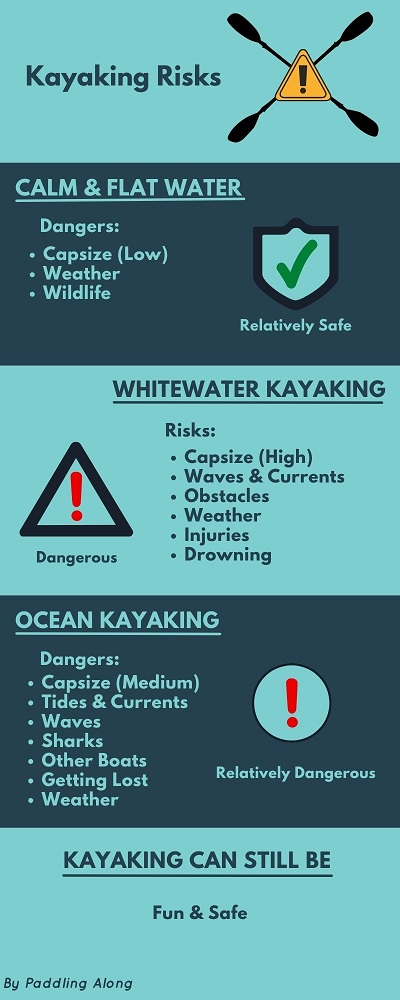
So, How Dangerous Is Kayaking?
With all the risks involved, kayaking is officially not totally safe. But now you probably want to understand how dangerous this sport is? The water body (lake, river, or ocean) in which you will paddle isn’t the only thing to consider.
It Also Depends On The…
Kayak You Use.
All boats aren’t the same, even if you compare multiple kayaks. Some are more appropriate and safe than others in specific conditions. Thus, it’s essential to select the right one for your needs.
You have to choose from 5 main types of kayaks. There are recreational, whitewater, sea/touring, fishing, and inflatable models. Each category offers a unique paddling experience because they are different, and designed for specific purposes.
Using any boat where it’s not appropriate can increase the risks involved. For example, paddling down rapids with a fishing kayak will be frustrating and dangerous.
It’s also essential to select an option that’s suitable for you. Whether your boat is too small or large, it can increase the risk of capsizing. So having the right type and size of kayak can help you make your adventures as safe as possible.
Water Conditions.
Although rivers and the ocean are more unpredictable than lakes, any water body will change. The level, currents, tides, and waves can vary from one day to another. So you need to make sure the water conditions are safe for kayaking before planning a trip.
When you decide to paddle can influence how dangerous kayaking is without necessarily being related to weather. For example, most rivers are likely to flood or have a higher water level between late winter and early spring. It means the rapids will be more dangerous at this time of the year.
The best way to know when it’s safe or not to kayak is to check out the forecasts. (Tides, level, waves, etc.) It will help you understand if the water conditions are too dangerous.
Another solution is to go out and take a look at the river/lake/ocean. You will quickly see if the level is too high, the waves too big, etc. In every case, kayaking when the water isn’t safe will put you more at risk.
Kayaking Skills You Have.
Your level of experience can also influence how risky this sport is for you. Experts know how to avoid dangerous sections and obstacles. If you’re just getting started, it’s another story. Beginners are more prone to capsize or make a mistake while paddling.
The more you practice something, the better you will get at it. With the right skills and techniques, it’s much easier to stay safe in your kayak. For example, you can stop it from tipping over with the low or high brace recovery method.
So a beginner is more likely to hurt or injure himself than an advanced paddler. But if you stick to an environment suitable for your experience, everything should be alright. There are also some dangers you can’t avoid regardless of your skills.
Situation.
Another thing you should keep in mind is the circumstances. Several other details of your paddling adventures can influence how dangerous they are. The gear you were, at what time you kayak, whether you go alone or with friends, and many other factors will come into play.
Everything you can think about might influence your safety on the water. Being well prepared and careful are the best ways to prevent as many problems as possible. Thus, it’s time to gear up and improve your kayaking skills.
Kayaking Compared To Other Sports!
Now that you have a better idea of how dangerous kayaking is for you and what risks it involves. Let’s put it side-by-side with other activities. For comparison, I’ve found the table below with the fatality rates of multiple sports.
| ACTIVITIES | FATALITY RATES – 1998 |
| Scuba Diving (1996) | 3.5 |
| Climbing: rock, snow, ice (1997) | 3.2 |
| Kayaking Whitewater | 2.9 |
| Recreational Swimming | 2.6 |
| Bicycling | 1.6 |
| Drowning (in public places) | 0.9 |
| Whitewater boating(based on 94-98 user days) | 0.86 |
| Hunting (1997) | 0.7 |
| Skiing and Snowboarding | 0.4 |
The information above comes from this article on American Whitewater in which they mention all the statistics resources. It doesn’t include all the kayaking types, but it can give you a relative idea of how dangerous this sport is.
The data is quite old, and kayaking has evolved a lot since 1998. So here are some more recent numbers I’ve found on the 2017 Recreational Boating Statistics created by the US Coast Guard.
Total Injuries For The Vessel Category Canoe/Kayak In 2017: 107.
Total Deaths For The Vessel Category Canoe/Kayak In 2017: 138.
With those numbers, you can understand that this sport isn’t as dangerous as most people think. On the other hand, keep in mind that it only includes kayak accidents counted by the Coast Guard. There are probably many other cases unknown by this organization.
Kayaking Dangerousness | FAQ
If you’re curious like me, you probably have multiple additional questions regarding the risk of this activity. You might have specific conditions or merely want to instruct yourself. Either way, you should be satisfied with the information below.
Is Kayaking Safe For Non-Swimmers?
Swimming isn’t necessary for this sport because you can always wear a life jacket. But you will need to swim (with your personal flotation device on) if you fall in the water. So kayaking can be safe for non-swimmers as long as they have the right gear and learn proper techniques to recover in case of capsizing.
Is It Dangerous To Kayak Alone?
Paddling alone isn’t as safe as with other kayakers. There are more risks involved because you won’t have anybody to help if you get into trouble. Kayaking alone is dangerous and not recommended regardless of your experience. Having a partner to paddle with can save your life in certain situations.
Is Kayaking At Night Safe?
Kayaking at night is more dangerous than during the day because you have reduced visibility. It means you won’t be able to see and be seen. So how can you avoid risks if you’re practically blind? But with the proper lights and equipment, it can be relatively safe to kayak after dark.
Learn More About Night Kayaking!
Can You Die Kayaking? | Kayak Deaths
You can die while kayaking. According to the Coast Guard Report, there have been a total of 138 deaths involving a kayak or canoe in 2017. It’s also the second type of vessel with the highest percentage of death. (15%) Thus, the risk of an accident being fatal is relatively high.
5 Safety Tips Every Kayaker Should Know!
Once you understand all the risks and dangers involved, it’s time to prevent them. There are many ways to keep you from having an accident while kayaking. You can take a few precautions to make your paddling adventures as safe as possible.
Gear Up Properly.
Preparation is the key to success. Without the right equipment, kayaking can be extremely dangerous. The personal flotation device is essential to provide you with buoyancy and keep your head out of the water if you capsize.
But there are also other essential pieces of gear you should have for safety purposes. A helmet, first aid kit, GPS, whistle, and many other accessories can be helpful for your paddling adventures. If you’re not well equipped, you’re more at risk.
Know The Area You Paddle In.
Before kayaking somewhere, you should understand the dangers of the environment. Every place is different, so don’t head out in the water without knowing what to expect. Understanding your surroundings will help you reduce the risk.
You must know the local hazards to ensure you can avoid them or react the right way if they happen.
There might also be some rules you should be aware of in the area you plan to go. So it’s your responsibility to find out the information necessary to paddle somewhere safely.
Look At The Weather & Water Conditions.
As I already told you, the weather can impact how dangerous it is to kayak. So you should always take a look at the forecast. You don’t need to cancel your trip because of a little bit of rain or strong winds, but at least you will be ready for it.
Learn more about kayaking in the rain!
Even though water conditions are closely related to weather, it’s still a good idea to analyze them separately. Because tides, surface levels, currents, and many other aspects of a water body will vary regardless of how beautiful the sky is.
Don’t Mix Alcohol or Drugs With Kayaking.
One of the principal causes of kayak accidents is alcohol or drugs. Although it can seem like a fun experience, paddling without all your means isn’t safe. Being impaired on the water makes you more likely to capsize or put yourself in trouble.
You shouldn’t mix any physical activity with alcohol because it increases the risks and dehydrates you. Thus, drinking water would be less dangerous and more appropriate while kayaking.
Know Your Limits.
The lack of experience mixed with hazardous waters is the source of most kayak accidents in the USA. So your skills might influence where you can paddle safely.
Not everyone can go down class IV or V rapids. That’s why you have to understand what limits are. With that in mind, you should find an appropriate place to go kayaking for your level.
Last Thoughts About How Dangerous Kayaking Is!
Finally, the risk involved in kayaking will vary a lot from one situation to another. This water sport can be both safe and dangerous. It will all depend on your perception and the circumstances in which you practice it.
However, the hazards are numerous and existent. Currents, waves, obstacles, weather, inexperience, and many other things can lead to capsizing, hypothermia, dehydration, or drowning in the worst-case scenario.
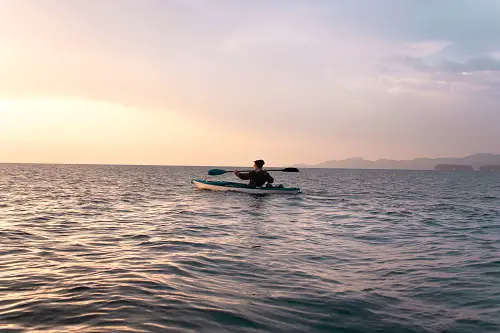
I hope my article has helped you understand if and how dangerous kayaking is. Now it’s time to stop asking questions and head out in the water. As long as you’re well prepared and equipped, everything should be fine.
Paddle On & Have Fun!
